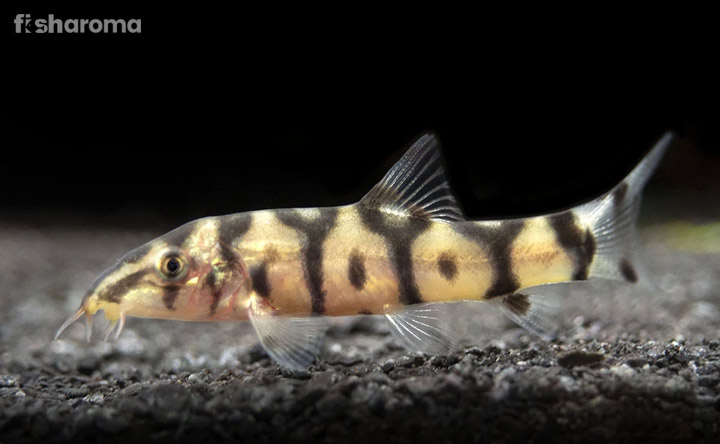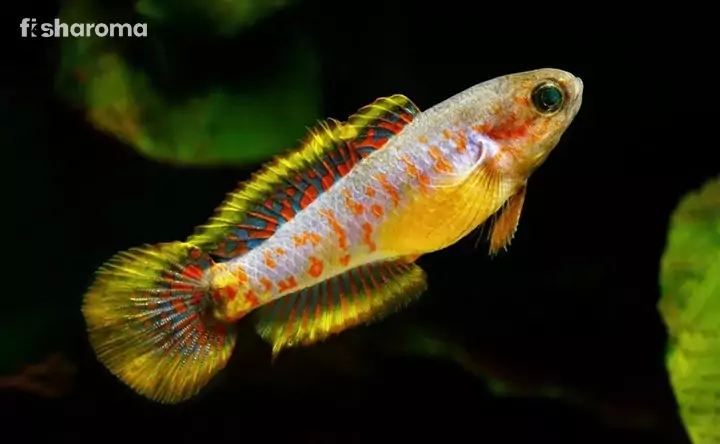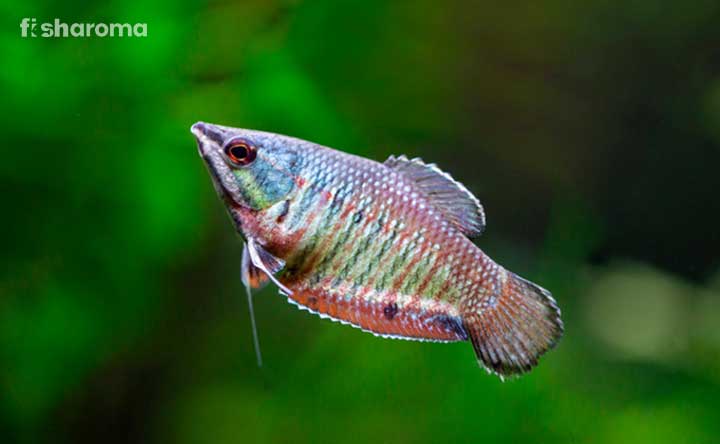Red Tail Shark Care Guide – Behavior, Diet, Tank Requirements and More

Isn’t it fascinating to sit on your couch in the living room and stare at a tank that hosts a shark? Just the sheer idea of having one at your home is bound to give you an adrenaline rush like no other. But you would be highly mistaken if you conclude that hosting a shark would lead to a bloodbath in your fish tank. Not all of them are fearsome killers. One such species is the Red Tail Shark whose care guide is what we are presenting to you here. This is one fish that definitely is more impressive than its appearance. So, let’s find out what makes it so intriguing.
Key Specifications of Red Tail Shark
Before we take a deep dive into the world of a Red Tail Shark, take a look at its key specifications.
| Scientific Name | Epalzeorhynchos bicolor |
| Family | Cyprinidae |
| Origin | Thailand |
| Size | 6” (15 cm) |
| Color | Black, Red |
| Care Level | Moderate |
| Lifespan | 4-6 Years |
| Temperament | Semi-Aggressive |
| Compatibility | Moderate |
| Tank Size | 50-Gallons (Minimum) |
| Diet | Omnivore |
Overview
Members of the Cyprinidae family, Red Tail Sharks have seen a spike in their popularity in recent years. They are mostly non-demanding in their care despite their fierce persona.
Fortunately for some and unfortunately for others, they aren’t actually Sharks at all in spite of their name. They are in fact, a species of Carp. They are called Sharks due to the shape of their dorsal fin.
Tracing the roots of their scientific name Epalzeorhynchos bicolor gives us an interesting story of their most prominent features. The first part of their name – Epalzeorhynchos – which is called the genus name – is a portmanteau of ‘Epalzeo’ which means horn, which is in reference to their protruding cone-shaped snout. The second part of their name ‘Rhynchos’ is Ancient Greek for snout or beak.
The second part of their scientific name – bicolor – which is the specific name, is in relation to the color pattern of their body.
Origin & Habitat of Red Tail Shark
Native to Western and Central Thailand, Red Tail Shark is a freshwater species that originated from the Chao Phraya, Mae Klong, and Bang Pakong rivers, all of which ultimately drain into the Gulf of Thailand.
They can be found in shallow ponds with clean flowing water that has plenty of rocks and a sandy substrate. During the rainy season, they migrate to forested areas and floodplains. This migration has been deduced to be the result of human intervention.
Appearance of Red Tail Shark
With an elongated and slim body that is flattened from sides, Red Tail Sharks have a curved back. They have an inferior mouth that has two pairs of bards. Their uniquely-shaped mouth makes them an excellent algae-scraper.
It is almost next to impossible to differentiate between the male and female Red Tail Sharks in their juvenile stage. However, as they grow, females tend to have a fatter and well-rounded abdomen than their male counterparts.
Size of Red Tail Shark
Mostly, these sharks grow up to 6” (15 cm) in length, but specimens of even 8” (20 cm) have also been cited.
Color of Red Tail Shark
Red Tail Sharks have a jet black body along with a complimentary red forked tail. The eyes located on its head are also bright red in color. When exposed to stress, the redness of their tail starts fading away.
Red Tail Sharks are often confused with Rainbow Sharks. Although they both originate from the same family of Cyprinidae, they both are of different breeds. While the fins and tail of Rainbow Sharks are both red, in Red Tail Sharks, only their tail is of red color.
Behavior of Red Tail Shark
In their juvenile form, they are fairly timid by nature, which is why they can be mostly seen hiding. However, as they grow older, their shyness converts to aggressiveness. They become extremely territorial and hostile towards other fish. While they don’t necessarily harass or bite other fish, they chase them to the point of severe exhaustion.
Being the bottom-dwelling fish that they are, they spend most of their time near the substrate of your tank. During feeding, they are known for bullying other small fish, especially if a bunch of fish is kept in close proximity with them.
Lifespan of Red Tail Shark
The average lifespan of a Red Tail Shark is 5-6 years, but in a well-cared environment, they have been noted to live up to even 10 years or more.
Diet of Red Tail Shark
Omnivores by nature, they have a diverse range when it comes to the type of food they consume. From crustaceans to plants, from worms to insects, they eat it all.
They are also noted scavengers. Besides live food, you can also feed them frozen food, pellets, and flakes. In addition, they also love to feed on algae, which will not only keep their tummy full but also keep your tank clean.
A proper diet of a Red Tail Shark should consist of the following items
- Brine Shrimp
- Bloodworms
- Krill
- Daphnia
- Blanched Cucumber
- Peas
- Sliced Fruits
- Zucchini
- Peas
- Spinach
- Peeled Squash
Coming to artificial food, you can choose any of the following for this Shark:
- API Fish Food Pellet
- Tetraveggie
- Hikari Sinking Wafers
- Fluval Bug Bites
Don’t forget to shred the pieces of food into small pieces so that they don’t choke on them. In addition, do not overfeed them. Whatever quantity they can consume within two minutes, just provide them that only. Remove any excess food from the tank within 24 hours in order to avoid any sort of contamination. Feed them 2-3 times a day.
They prefer vegetable and plant matters more than meat, so keep that in mind while planning their diet cycle every week. A proper diet would also help in maintaining the bright color of their tail.
Tank Requirements for Red Tail Shark
In order to give this fierce beast the best living condition that replicates its natural habitat, you need to keep the following points in mind.
Tank Size
Since they are highly territorial in nature, you need to provide them ample space to keep them calm. For a juvenile, a 29-gallon tank is required, while for an adult, you would require at least a 55-gallon tank.
Nature of Lighting
The need for a proper lighting system is because of its contribution towards the growth of algae and other related microorganisms, which this Sharks feed upon. Therefore, fix a moderate to bright light in your aquarium.
Substrate
Gravel-based substrates such as small pebbles are an ideal choice for this freshwater species.
Tank Lid
They are good jumpers. So, keeping them in an open tank is not wise. Make sure you have a lid for your tank. Also, ensure that there is at least 6-8” (15-20 cm) space between the water surface and the tank lid so as to facilitate safe jumps for them.
Filter
Red Tail Sharks aren’t much fussy about the kind of filtration they need. A simple hang-on-filter will get the job done. However, if you have a very large tank and can afford a big budget, then go for a canister filter.
Ornaments
As we have stated above, these freshwater species spend the majority of their time hiding, especially in their juvenile days. Therefore, the inclusion of rocks and aquatic caves is a must in a Red Tail Shark tank. You just need to ensure that the rocks and caves don’t have any prickly or sharp edges to them.
Presence of Flora
Aquatic plants would act as additional hiding spots for them. Remember, these fish feed on plant matters. So, try to pick artificial plants or if you really want natural plants for your tank, go for the hardy ones. Anubias, African Water Ferns, and Microsorum are the most suitable options for them.
Cleaning Method
You need to clean your tank at least once a month. It includes everything from wiping the glass walls with a soft cloth to putting the ornaments and substrate under running water. The only thing you need to be careful of here is to not to use any soap or chemical-based product for cleaning purposes.
Water Type for Red Tail Shark
With the tank set up, the next focus area should be the water type for these fish. So, let’s find out the parameters you need to bear in mind when selecting the apt water for them.
Temperature
Since they live in primarily warm water, try to maintain the temperature of the water 72-79° F (22-26° C).
pH Level
They inhabit neutral water in the wild. Thus, try and keep the pH level of the water 6-8.
Hardness
The hardness of the water should be 5-15 dH.
Replacement Procedure
We recommend you to schedule water replacement of your tank on a regular basis. This would not only help you get adjusted quickly since you would know when to carry out the procedure, but it would also help your fish get used to it.
If you want to conduct this procedure on a weekly basis, then you need to replace 10% of your tank’s water. If you choose to do it every 15 days, replace 20% of the water; and if you want to do it on a monthly basis, then replace 40% of the water.
The new batch of the water should be of the same above parameters (temperature, pH level, and hardness) as that of the existing batch of water in your tank.
Remember not to replace the entire water content altogether since that would kill off the beneficial bacteria present in your tank. Moreover, it will also be difficult for your fish to adapt themselves to the new uncycled water.
Compatibility of Red Tail Shark
Although they are not recommended for a community tank due to their territorial nature, we are not asking you to keep them all alone. For a beginner aquarist though, it is best to keep them alone since for each fish, you would need an exceptionally large area.
In addition, if you want to keep multiple Sharks together, then you must have a batch of at least five since that would avoid the creation of an alpha who bullies the weaker one.
Each Red Tail Shark needs at least 1 meter of the tank’s length.
Suitable Tankmates for Red Tail Shark
They are usually hostile towards any species that look similar to them. They will chase any small, peaceful fish to exhaustion and cut out their food supply, thereby endangering their health.
When picking tankmates for a Red Tail Shark, go for fast, robust ones who can outswim them and who spends the majority of their time in the upper or middle portion of the tank. Ideal tankmates for them are as follows.
- Angelfish
- Gourami
- Clown Loach
- Neon Tetra
- Glowlight Tetra
- Rummy Nose Tetra
- Emperor Tetra
- Cardinal Tetra
- Danio
- Barb
- Bala Shark
Unsuitable Tankmates for Red Tail Shark
Peaceful fish shouldn’t be kept with them under any circumstance. You also need to avoid keeping any fish that are prominently red-colored. Furthermore, since they are a bottom-dwelling fish, try to avoid keeping other bottom-dwellers with them.
Species that should NOT be kept with a Red Tail Shark are as follows.
- Cichlid
- Pleco
- Rainbow Shark
- Catfish
Breeding of Red Tail Shark
If you are planning to breed a Red Tail Shark at home, let us warn you against it. They are extremely difficult to breed in a home tank. Only commercial tanks have bred them successfully, and that too, after adding hormones to their ponds.
Unfortunately, their population in the wild is almost next to none. This is why we are so dependent on commercial breeding facilities to keep their numbers up.
This egg-laying fish spawns in rocky caves. After the females lay eggs and the males fertilize them, it takes around 40-60 hours for them to hatch. Interestingly, the fries change their color from silver to brown to ultimately black, which is mesmerizing to watch. The trademark red tail starts developing when they are ten weeks old.
Red Tail Shark Diseases
Similar to other freshwater fish, a Red Tail Shark is vulnerable to common aquatic diseases, although they are easily treatable.
One of the most common issues that raise a concern is when your tank has an overabundance of ammonia. It would result in your fish gasping for air at the water surface and they will have inflamed red gills. To avoid this, do not overcrowd your tank and have a good filtration system that would not only cycle the tank well but also efficiently eliminate the waste produces of these fish.
Dropsy (marked by trouble in swimming and a bloated stomach), Ich (white spots on the fins and body), and fish fungus (white/gray cotton-like growths on the body) are the other diseases that can strike your Red Tail Shark.
To avoid them, you need to replace your water and clean your tank on a regular basis, quarantine new fish or new products that you add to your tank, and take proper medical help. In case of Ich, increasing the temperature of the water to 82° F (27° C) helps in killing off the parasite responsible for it. Remove any trace of parasite or fungus (in case of fish fungus) from the tank on an immediate basis.
Interesting Facts about Red Tail Shark
- Red Tail Sharks are also known as Red Tail Shark Minnow, Fire Tail, Red-Tailed Labeo, and Red Tail Black Shark.
- The International Union for Conversation of Nature (IUCN) has listed them as “Critically Endangered”.
- There have been reports of Red Tail Sharks forming alliances with Clown Loaches in captivity.
Summary
Red Tail Sharks are a freshwater species that have the tendency to be territorial and hostile towards similar-looking fishes. A bottom-dwelling omnivore by nature, they mostly keep to themselves unless provoked. They don’t have high demands when it comes to their tank requirements and taking care of them is possible, even for a beginner, as long as you are not keeping more than one of them together. In addition, they can’t be bred at home. So, you will have to buy them from the market if you want to host another one in your tank.
Similar Guides of Freshwater Aquarium Pets
If Red Tail Sharks have caught your attention, then we are sure you would appreciate these other freshwater aquarium pets as well.
- Crowntail Betta: The crowning jewel of any freshwater tank, a Crowntail Betta will elevate the aesthetics of your aquarium like no other.
- Jack Dempsey Fish: If aggressive and feisty fish is your taste, then not having Jack Dempsey in your tank would be a cardinal sin.
- Black Ghost Knifefish: If you feel brave enough to host an unconventional pet in your freshwater aquarium, then this is a recommended option for you.









